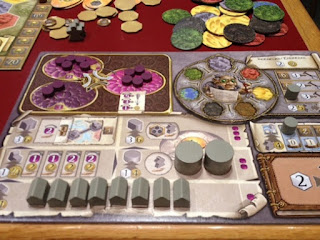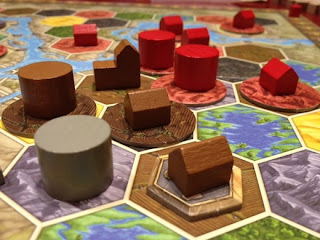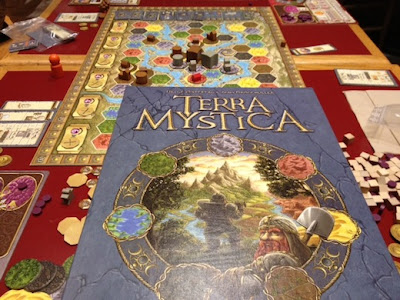An insanely popular game right now is Terra Mystica. So, when I was offered an opportunity to try it out, I gladly accepted.
In Terra Mystica, each player represents a fantasy race that is attempting to expand. Unfortunately, only one habitat is viable for them to build upon, and so they must regularly terraform different parts of the world in order to spread out. The game is played over six rounds, and in each round players first collect income, then they alternate taking actions, and finally, they collect bonuses. The different actions can include terraforming and/or building a dwelling, improving their shipping, improving their skill at terraforming, upgrading a structure, improving on one of the "cult" tracks, taking a "power" action, taking a "special" action, or passing for the round. Each of these actions requires a different combination of workers, gold, and priests. And many of these actions will give you victory points as you perform them. At the end of the round, each player has the chance of gaining additional bonuses (like free terraforming actions) based on how far he has moved along one of the cult tracks. At the end of the sixth round, players get extra points based on how far along they have moved on each of the cult tracks, and also for how many connected structures they have. Whoever then has the most victory points is the winner!
My first pro for Terra Mystica is all of the different races. And, I especially love the fact that each of the races is truly different. There are 14 different races in the game, and though they can all perform the same actions, they each have strengths and weaknesses for you to exploit. Some races will be able to upgrade structures very inexpensively, but will not have many workers that they can collect. Others can move quickly up the cult track by allowing other players to gain "power" (something I haven't talked about yet). One race is amazing at shipping, and can easily connect structures that are significantly far apart, whereas another race can convert money into victory points (and back) in order to give them the flexibility to do whatever they need on any given turn. Now, with this pro, I will freely confess that, though the races seemed balanced when I played, I have not played the game enough to authoritatively say whether or not they are all balanced or if one of the races might be better or worse than some of the others. Regardless, the different races in the game make it a much more enjoyable experience and help each game to feel unique.
 |
| Player board showing resources and power pools |
The last pro that I will mention for Terra Mystica (there are several others that I'm skipping) is that I like the rewards of upgrading - and for that matter, I like the balancing of resources all together. Based on what buildings you build, you get different resources. If you build a lot of dwellings, then you will get a lot of workers; if you build trade houses, you will get money, and if you build temples, you will get priests. However, each time that you upgrade a building, you return the previous building to your player board - and thus you lose whatever bonus you had for the returned structure. So, if you upgrade a dwelling to a trade house, then you will no longer receive a worker, but you will start to receive money. The upgrades that I especially like are upgrading to temples/sanctuaries, and to strongholds. When upgrading to a temple (or sanctuary), you get a "favor" token. These tokens give you bonuses in the game and can help you in a plethora of ways. The strongholds, however, unlock something different for each race. So, some races will do extremely well if they can build their stronghold quickly, whereas others will do fine building their stronghold on the last turn of the game. The strategies that go into what to build, or when to upgrade, are critical decisions that will influence you in a number of ways.
 |
| These structures will now peacefully co-exist |
Now that we've come to the cons section of Terra Mystica, there is only one con that really jumps out to me. There is a lot going on in this game. And, to a certain extent, you will probably ignore a fair amount of it, based on which race you are. In the games that I have played, most players have never taken at least one of the different available actions. For example, if you use the Engineers, then you will build a lot of bridges, and will probably never improve shipping. Conversely, if you are the Mermaids, then you will very rarely have a reason to build a bridge. Depending on your strategy, you may also never choose to improve your ability to terraform. Now, some people may actually see this as a positive, as you have the ability to make different choices from one game to the next, and you aren't forced to do the same thing every time. However, it makes me wonder if the game could have been a bit more streamlined, and thus played a touch faster. This isn't a major problem with the game, it is simply something that I think might have been able to be improved.
Overall, I give Terra Mystica an 8.5/10. I enjoyed my plays of the game and, though it is a bit longer than I normally prefer, it is a game that I can see myself continuing to play and explore.
If Terra Mystica sounds interesting, you might also check out Caylus, In the Year of the Dragon, and Notre Dame.
I would like to thank Z-Man Games for providing me with a review copy of Terra Mystica.



0 komentar:
Posting Komentar